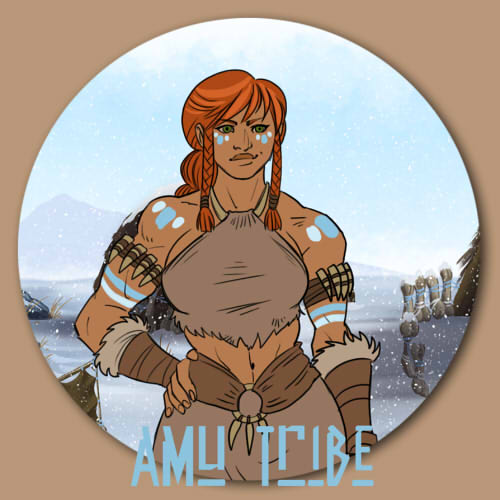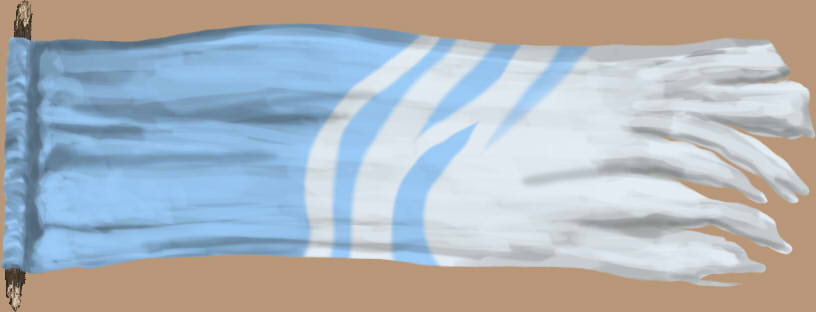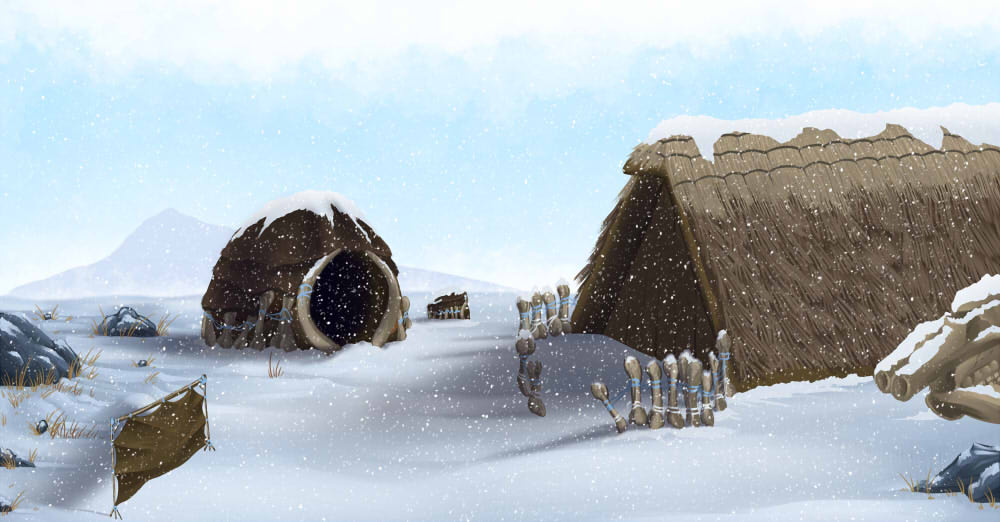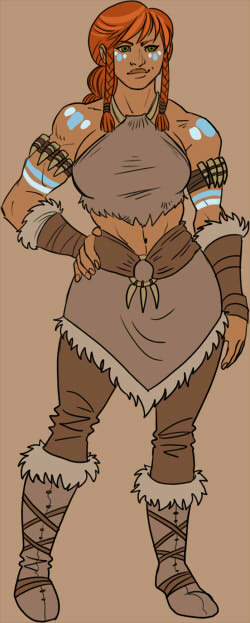
Welcome!
Here you can find details about the Amu Tribe, their leader and where / how they live. On top of the page you will also find their banner with their primary colors used for paints, etc.



Their leader:
Name: Thupis
Species: Human (Homo Sapiens)
Gender: Female
Sexual Orientation: Pan
Partner: None
Personality: Kind and calm. Is very good with animals and befriends them very easily. Due to being the youngest leader she has some insecurities and often second-guesses her decisions.
Tribe Structure:
The bitter cold is harsh, ruthless and unpredictable. The weather can change as quickly as the wind so the nomadic Tribe rely heavily on one person to make quick decisions. There is no room for argument or community spirit; clear decisions and a loud voice is needed when the risks are freezing to death or being trampled by a stampede of mammoths. Thupis is Amu’s current leader, and though she is young and second-guesses herself, she has proven herself trustworthy with her kindness and calmness. Though her kindness is merely a bonus, the fact she is capable of remaining calm even in the face of danger gives her an advantage over most who might freeze on the spot or break down in fear.
Her presence as a leader is also secured solely by the fact that Thupis is the only Tribemember who managed to tame an Ursus. Whereas the rest of the Tribe have made beast companions of Worgs and Megaloceros to help push through the snow drifts, protect their valuable Musk Ox herd and hunt down the necessary food for the Tribe’s survival.
Similar to the Tamasun Tribe, the Amu Tribe also has a food hierarchy, though with some differences, depending on the stock of food they have. On the days when food isn’t dwindling, the Amu Tribe have shared portions of decent amounts to help everyone keep going. No one eats less or more than others. On days when food is scarce, rations are handed out and the only ones eating second helpings are those sick, pregnant or with infants.
There once had been a structure where hunters and shepherds would eat more than others so they would be able to withstand the cold longer and have the strength to protect the Musk Ox or hunt more food. Today, however, the Amu Tribe are a selfless lot who would offer their own portion of food to someone else who needed it more. This has not only helped the tribe survive and thrive, but it is forming a stronger bond between the Tribe that had once been lacking.
Their habitat:

– They live in a Tundra
– Their tribe is semi-nomadic:
– During the winter months all tribe members including their livestock live in a large cave
– During the summer months the sheperds and their livestock roam the area while the rest of the tribe stays in the cave
– Two (2) longhouses can be found in the surrounding area. These will be used both by the sheperds and the livestock during really cold nights to keep
everyone warm
– For the other nights the sheperds use small hovels to sleep / rest in while their livestock grazes outside
The people:
– Due to negative experiences with poachers trying to hunt down some of their livestock, the members of the Amu Tribe are neutral towards strangers. However, once someone proved they can be trusted and mean no harm the Tribe normally warms up to them rather quickly.
– Despite having their own livestock the Tribe still actively hunts and forages for a more diverse diet. They also have a talent for finding rare items they regularly trade for other things such as food they cannot find in their own area.
– Their favourite god is Arwii, the God of Life. Members of the Amu Tribe value life and it is not unusual for them to take in beasts and people alike who are in need of help or would not be able to survive out in the wild.
– As their habitat can be quite dangerous for the young and unexperienced, young members are kept in and around the cave under a close eye until they learned everything they need to know to survive in the wild.
– Neither is it unusual for Tribe members to have companions of any species. However, unlike other tribes, these companions are not normally seen inside their cave or huts. While being close with their humans it is more usual for them to live outside, living a semi-wild life.
Their history:
The Amu Tribe is an old Tribe whose history dates back to before mortality was cast upon the Prehistorians. Much like the Elloulk, they once called Donii Lake their home before fear took hold of their neighbours and drove them to the frozen wastes of the North for a chance at survival. It was slim, but even a slither of a chance was better than death at the hands of those they once called friends.
Their few numbers became fewer still as the cold proved to be too much for them to handle on their own. But salvation came to them in the most unlikeliest of forms; the Musk Ox. Much easier to tame than a foul-tempered woolly rhino yet not as large or hard to handle as the wandering mammoth. They gathered up a herd to call their own, using the Musk Ox’s dense fur as clothing and protection from the elements, their meat and milk to feed them and their bones to craft weapons and temporary structures. With time and practice, the Amu Tribe survived not just a massacre but also a place once thought inhospitable.
Despite their survival and hardy nature given to them from living in such a place, the Amu Tribe never settled like the other Tribes. It isn’t known to outsiders if it was out of fear of a repeat of history or if it was purely because they were so stuck in their ways of migrating with the Musk Ox that they never thought to change their lifestyle and settle down.
But it wasn’t just Musk Ox that the Amu Tribe are known to have tamed; smaller canines than the Worgs are bred and trained to pull sleds that the Tribe use as forms of transporting goods from one place to another; whether it is an injured person needing quick treatment or hunting goods that need to be prepared and stored for the longer Winters. A far quicker and more simpler method of transport than relying solely on the backs of their beasts who, though large and capable of carrying weight, would be hassled with ropes and bonds to keep things in place on their backs.
